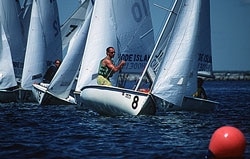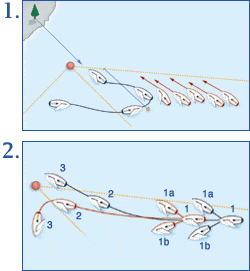
If the pin is favored, many sailors will jockey for the perfect pin start. The ability to leg out on starboard below the fleet or to tack and cross the competition is an advantage worth fighting for. Of course, you may have to battle for it; rarely will a good fleet give you the pin end at the start. The trick to winning the pin is to control the situation and take charge of your own destiny. There are two match-racing moves that can help you win the pin, but you must make one critical decision: Do you lead the pack to the pin, or do you push them?
Leading to the pin
This maneuver is best executed with a port-tack approach to the line. In a typical starting scenario, the flow of boats will move counterclockwise between the race committee boat and the pin. If you want to lead the pack to the pin on starboard, its best to be the last boat on port and tack closely to leeward of the boat nearest to the pin. A port-tack approach allows you to see any available holes and how others are positioning for the start. Tacking tightly below the boat closest to the pin allows you to control the situation. From this position, you can prevent the boat above from moving towards the pin, and you can herd the pack in a windward position while protecting your hole to leeward. A critical element in making this work is the concept of “time and distance.”
In order to accurately position yourself to win the pin, you need to gauge how far away you are from that sweet spot, and exactly how long it will take you to get there. Its important to spend some time in your pre-race preparation gathering this information. Being one or two seconds early can ruin your start, forcing you to jibe around into traffic. To properly execute this start, you must know three things: 1. How long it takes you to sail the length of the line. 2. How long it takes you to get from any stationary object in the water, a lobster pot or anchored spectator boat, back to the pin. 3. How long it takes you to tack and accelerate. The time to sail a given distance will vary with your sailing angle–reaching is faster than running or beating. And dont forget to consider current set.
Once youre in a lee bow “leading” position, your time and distance homework should pay off as you pick the moment to put your bow down towards the buoy, accelerate, and win the pin start. The biggest risk is a rogue boat coming in from astern attempting to snatch your hole while youre herding the pack above. Keep a wary eye astern, and to discourage a rogue boat, put your bow down, ease your boom out, and close the distance with the pin layline. Make it obvious that the rogue will not be able to sail to leeward of you and still fetch the pin. In fighting off the rogue, however, make sure you dont underestimate the time and distance required to reach the pin. In other words, dont run out of room yourself.

The best times to lead back to the pin are: 1. In light air, because tacking angles are wider and you can accelerate more easily with no one under your bow. 2. When you have a large runway available to the pin. 3. If a pack of boats is crowding toward the pin. With everyone overlapped, its much easier to control the group.
Pushing to the pin
Pushing an opponent is another way to win the pin, but it requires a keener sense of time, distance, and layline position. Before the start, test the layline to get a feel for its position, and then sight through the pin for a marker on land–a shore sight. Check this layline reference several times to ensure that its accurate–wind shifts will cause it to change.
Pushing is most effective when youre vying with one other boat for the pin. Its more effective in stronger wind because its easier to accelerate and the ability of the lead boat to slow and stop is reduced. Pushing requires using the match racing technique of tailing another boat closely. The goal is to force the lead boat to use up its runway to the pin, forcing it to luff and slow prematurely. This should allow you to establish a leeward controlling position, or to pressure the lead boat into being early and jibing out.
When pushing the lead boat toward the pin, match their sail trim and angles in order to stay on their transom without gaining a weather overlap. As you push, the lead boat will probably fishtail back and forth, trying to slow its rate of progress toward the pin and attempting to “hook” your bow into a weather overlap. If you become trapped to windward, the lead boat has won. With luffing rights, the lead boat can control the action, slow its approach to the pin, and create a hole to leeward.
As the lead boat tries to hook you, your move is to bear away, cross their transom and overlap them to leeward with speed. If you can establish a substantial overlap to leeward early in this dance, you can then luff and stop the lead boat and control the approach to the pin. If the lead boat bears away before you get a solid overlap, youll soon fall astern in their dirty air.
Once astern, you have two choices: the first is to aim for the pin and continue sailing fast, forcing the lead boat to match your course to stay ahead. Alternatively, you can luff sharply if youre running out of time or if the lead boat has sailed past the pin layline.
As the pusher, keep in mind that if you establish a leeward position from clear astern, you are required to assume your proper course after the start. If you have erred on time and distance, misjudged the layline to the pin, or trapped your bow to leeward with mere seconds to go, youre in big trouble. At best, youll have a second row start; at worst, you may not fetch the pin.
Having a great start almost ensures that youll be in the top pack up the first beat. Confidence in your ability to handle the boat in tight quarters, hold position, generate and protect a hole below your bow, and accelerate at the proper time are vital to winning the pin. One match racing technique that helps is backing the jib hard to windward to swing the bow down and accelerate without a lot of rudder movement.
There is nothing more satisfying than winning the pin and having all the options open to you. Try these aggressive moves in smaller, less competitive fleets at first. Then try them against a more competitive pack. Slowly, your timing, boat handling, and confidence will improve. The pin will be yours whenever you want it.









